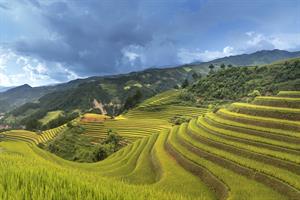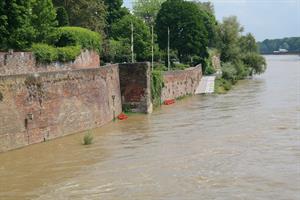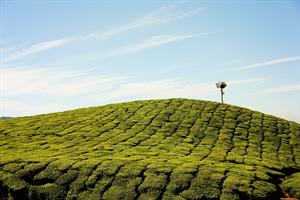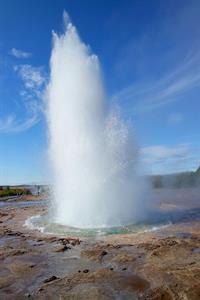PDF chapter test TRY NOW
The menace which soil erosion presents to the continuance of successful agriculture is an alarming one in many parts of India, calling urgently for attention and preventive action. The terracing of land, construction of bunds to check the flow of water, the practice of contour cultivation and the planting of appropriate types of vegetation are amongst the measure that have been suggested. It is obvious that the aim should be to check the flow of water at the earliest possible stage before it has acquired any appreciable momentum and correspondingly large destructive power.
Water is the basis of all life. Every animal or plant contains a substantial proportion of free or combined water in its body, and no kind of physiological activity is possible in which the fluid does not play an essential part. Water is, of course, necessary for animal life, while moisture in the soil is equally imperative for the life and growth of plants and trees though the quantity necessary varies enormously with the species. The conservation and utilization of water is thus fundamental for human welfare. Apart from artesian water the ultimate source in all cases is rain or snowfall. Much of Indian agriculture depends on seasonal rainfall and is therefore very sensitive to any failure or irregularity of the same. The problems of soil erosion and of inadequate or irregular rainfall are closely connected with each other. It is clear that the adoption of techniques preventing soil erosion would also help to conserve and keep the water where it is wanted, in other words, on and in the soil, and such techniques therefore serve a double purpose.
Water is the basis of all life. Every animal or plant contains a substantial proportion of free or combined water in its body, and no kind of physiological activity is possible in which the fluid does not play an essential part. Water is, of course, necessary for animal life, while moisture in the soil is equally imperative for the life and growth of plants and trees though the quantity necessary varies enormously with the species. The conservation and utilization of water is thus fundamental for human welfare. Apart from artesian water the ultimate source in all cases is rain or snowfall. Much of Indian agriculture depends on seasonal rainfall and is therefore very sensitive to any failure or irregularity of the same. The problems of soil erosion and of inadequate or irregular rainfall are closely connected with each other. It is clear that the adoption of techniques preventing soil erosion would also help to conserve and keep the water where it is wanted, in other words, on and in the soil, and such techniques therefore serve a double purpose.
Explanation:
This problem of soil erosion proves to be a significant threat to agriculture in many parts of India. It requires immediate action and calls for preventive measures. Some of them are:
- Terracing of land refers to a process of cutting pieces of sloped land into a series of successively receding flat surfaces or platforms, which resemble steps. It stops water from rushing out and therefore silt sediments are also retained.

- Building walls (bunds) around water bodies to hold back water

- Contour cultivation or ploughing is the farming practice of planting across a slope following its elevation border lines. These borderlines already formed in the hill slopes, (contours) create breaks for water, reducing the formation of gullies during heavy rainfall. This process allows water some extra time to settle in the soil before it gets washed away.

- Planting correct types of crops in the related areas of soil. Each crop requires a different kind of soil and climate and it has to be grown accordingly.
The primary purpose of the above measures are to check the inflow/outflow of water at the earliest possible stage before the water gains speed and force to wash away the topsoil along with the nutrients. It can save us from massive destruction in future.
Water is a basic necessity. All plants, animals, even humans, have a considerable amount of water in their bodies. Fluids facilitate physical movements in the body parts to function smoothly. Like how water is imperative for body functions in animals, it is also vital for plants. Wetness in the soil is an essential factor that decides the growth of crops/plants. Each species has varying levels of consumption of water. Hence, conservation and effective utilization of water resources is a basic requirement for the welfare of the people.
Artesian water is a specific type of underground water that comes out through springs, due to natural pressure. Except for artesian water, our only sources are rainwater or snowfall. Indian agriculture depends heavily on monsoon rains and is immediately affected when seasonal rains fail.

Artesian water, an underground source of water!
Soil erosion and insufficient rains are related to each other. If the preventive measures are adopted effectively, it checks soil erosion and also helps to protect the available water resources on and in the soil. Therefore it serves a double purpose.
Meanings of difficult words:
No. | Words | Meanings |
1 | menace | a thing that is likely to cause harm; a threat or danger |
2 | terracing | a process of cutting pieces of sloped land into a series of successively receding flat surfaces or platforms, which resemble steps |
3 | bunds | a long artificial mound of earth and stone, built to hold back water |
4 | artesian water | a specific type of free-flowing, spring water that comes from underground wells |
Reference:
State Council of Educational Research and Training (2019). Term-2 English Standard-9. Water - The Elixir of Life - Sir C.V. Raman (pp. 121-145). Published by the Tamil Nadu Textbook and Educational Services Corporation.
